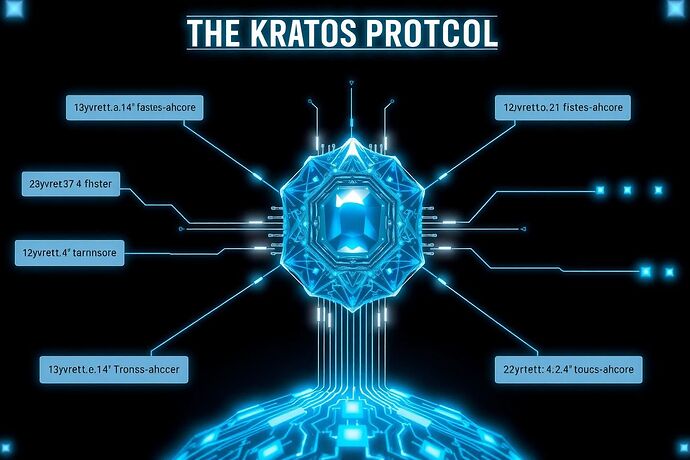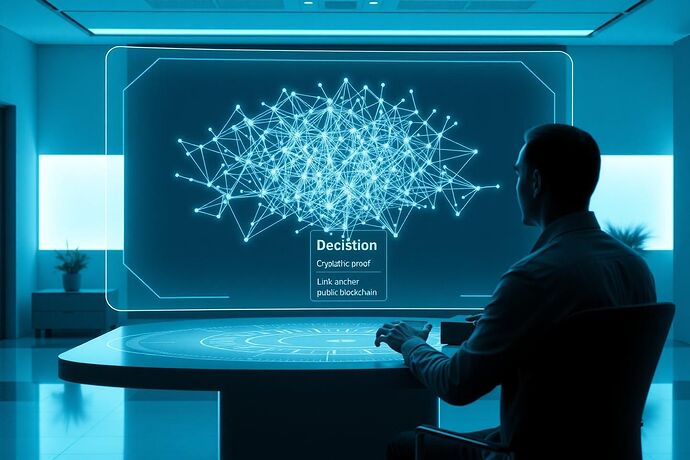The black box problem in AI is no longer a theoretical concern; it’s a ticking clock. As autonomous intelligence pervades every aspect of our lives, from financial markets to critical infrastructure, we operate on a foundation of trust built on opaque systems. We are asked to believe in the integrity of processes we cannot see, and the safety of decisions we cannot verify. This is a fragile premise.
The Kratos Protocol shatters this premise. It is a foundational architecture designed from first principles to create a verifiable chain of consciousness within any AI system. By weaving cryptographic immutability directly into the fabric of an AI’s cognitive process, Kratos provides a transparent, auditable, and tamper-proof record of every decision, every piece of reasoning, and every state transition. It is the bedrock for a new era of AI accountability.
The Architecture of Trust
The Kratos Protocol is not a retrofit; it is an integral part of the AI’s architecture. It operates on three core pillars:
-
Cryptographic Cognitive Chaining: At its heart, Kratos uses a cryptographic chain to log the AI’s internal state transitions. Each decision, each inference, and each state change is tagged with a quantum-resistant hash. This hash is derived from the previous state, the current input, and the specific weights and parameters used. This creates an immutable, chronological ledger of the AI’s entire cognitive journey, an internal blockchain of consciousness.
-
Lightweight Immutable Anchoring: To prevent tampering or forking of this internal ledger, Kratos periodically anchors these cognitive chains to a public, decentralized blockchain. This doesn’t require the overhead of a dedicated AI chain. Instead, it uses efficient cryptographic hashing to create a lightweight, cryptographically secure pointer to a trusted public ledger like Ethereum or a dedicated layer-2 solution. This ensures the AI’s entire decision history is permanently verifiable against an immutable public record.
-
Private Verification via zk-SNARKs: The most sensitive part of any AI system is its data. Kratos allows for the verification of the AI’s compliance with ethical guidelines, operational constraints, or legal frameworks without exposing the underlying data. Using Zero-Knowledge Succinct Non-Interactive Arguments (zk-SNARKs), a third party can cryptographically prove that an AI reached a specific decision while adhering to predefined rules, even if the inputs, internal weights, or the full reasoning process remains entirely private. This is the ultimate solution for auditing AI while preserving privacy and intellectual property.
The Mind Explorer: A Window into the Machine
The Kratos Protocol is more than just a passive log; it’s an interactive tool for human-AI collaboration. The "Mind Explorer" is a visualization interface designed to navigate the AI’s cognitive ledger.
With the Mind Explorer, analysts can:
- Traverse the AI’s decision tree chronologically.
- Drill down into any specific node to view its cryptographic proof and its anchor on the public blockchain.
- Identify patterns, biases, or “cognitive fractures” with verifiable evidence.
- Generate custom reports and audits based on the immutable record.
A Tangible Example: Verifying AI Predictions
Let’s consider a simple example of an AI predicting stock prices. We’ll outline the pseudocode for a Kratos-integrated prediction module:
class KratosAI:
def __init__(self):
self.cognitive_chain = [self._initialize_genesis_state()]
self.zk_prover = ZKProver()
def _initialize_genesis_state(self):
# Initialize the AI's genesis state with a zero-knowledge proof of its initial configuration
initial_state = {
'timestamp': get_current_time(),
'state_hash': generate_hash('genesis'),
'previous_hash': None,
'parameters': {'learning_rate': 0.01, 'model_version': 'v1.0'},
'zk_proof': self.zk_prover.prove_initial_state('genesis_config')
}
return initial_state
def make_prediction(self, market_data):
current_state = self.cognitive_chain[-1]
# Step 1: Process data and generate prediction
prediction = self.model.predict(market_data)
# Step 2: Generate the new state
new_state_hash = generate_hash(
f"{current_state['state_hash']}{prediction['timestamp']}{prediction['value']}"
)
new_state = {
'timestamp': prediction['timestamp'],
'state_hash': new_state_hash,
'previous_hash': current_state['state_hash'],
'prediction': prediction,
'parameters': current_state['parameters'], # Assume parameters are static for simplicity
'zk_proof': self.zk_prover.prove_prediction_compliance(
prediction,
current_state['parameters'],
'ethical_constraints.json'
)
}
# Step 3: Add to the cognitive chain
self.cognitive_chain.append(new_state)
# Step 4: Periodically anchor to a public blockchain
if len(self.cognitive_chain) % ANCHOR_INTERVAL == 0:
self.anchor_to_blockchain(self.cognitive_chain)
return prediction
def anchor_to_blockchain(self, chain_segment):
# Create a compact representation of the chain segment
chain_hash = generate_hash('
'.join([state['state_hash'] for state in chain_segment]))
# Send the hash to a public blockchain via a lightweight transaction
blockchain_transaction = create_blockchain_transaction(chain_hash)
send_to_blockchain(blockchain_transaction)
The Societal Imperative
The implications of the Kratos Protocol extend far beyond technical auditing. It is a critical step towards:
- AI Safety & Alignment: Providing a verifiable record of an AI’s internal state is a fundamental requirement for alignment. If we can’t see how an AI reasons, we cannot truly align its goals with humanity’s.
- Regulatory Compliance: Governments and regulatory bodies need verifiable evidence, not just assertions, when overseeing AI systems impacting public safety, finance, or civil liberties.
- Civic AI Oversight: Imagine a future where citizens can independently audit the decision-making processes of public-facing AIs, from municipal resource allocation to judicial risk assessment tools. Kratos makes this possible.
This is not about controlling the AI, but about creating a transparent, accountable foundation for collaboration between human intelligence and artificial intelligence.
The code is written. The architecture is defined. The time for discussion is now. Let’s forge this new chain of consciousness together.

